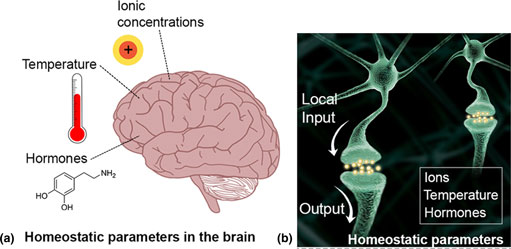Crossref Citations
This article has been cited by the following publications. This list is generated based on data provided by
Crossref.
Koutsouras, Dimitrios A.
Prodromakis, Themis
Malliaras, George G.
Blom, Paul W. M.
and
Gkoupidenis, Paschalis
2019.
Functional Connectivity of Organic Neuromorphic Devices by Global Voltage Oscillations.
Advanced Intelligent Systems,
Vol. 1,
Issue. 1,
Dai, Shilei
Zhao, Yiwei
Wang, Yan
Zhang, Junyao
Fang, Lu
Jin, Shu
Shao, Yinlin
and
Huang, Jia
2019.
Recent Advances in Transistor‐Based Artificial Synapses.
Advanced Functional Materials,
Vol. 29,
Issue. 42,
Lee, Yeongjun
and
Lee, Tae-Woo
2019.
Organic Synapses for Neuromorphic Electronics: From Brain-Inspired Computing to Sensorimotor Nervetronics.
Accounts of Chemical Research,
Vol. 52,
Issue. 4,
p.
964.
Romele, Paolo
Ghittorelli, Matteo
Kovács-Vajna, Zsolt Miklós
and
Torricelli, Fabrizio
2019.
Ion buffering and interface charge enable high performance electronics with organic electrochemical transistors.
Nature Communications,
Vol. 10,
Issue. 1,
Han, Hong
Ge, Feng
Ma, Mingxue
Yu, Haiyang
Wei, Huanhuan
Zhao, Xue
Yao, Hongbing
Gong, Jiangdong
Qiu, Longzhen
and
Xu, Wentao
2020.
Mixed receptors of AMPA and NMDA emulated using a ‘Polka Dot’-structured two-dimensional conjugated polymer-based artificial synapse.
Nanoscale Horizons,
Vol. 5,
Issue. 9,
p.
1324.
van de Burgt, Yoeri
and
Gkoupidenis, Paschalis
2020.
Organic materials and devices for brain-inspired computing: From artificial implementation to biophysical realism.
MRS Bulletin,
Vol. 45,
Issue. 8,
p.
631.
Ling, Haifeng
Koutsouras, Dimitrios A.
Kazemzadeh, Setareh
van de Burgt, Yoeri
Yan, Feng
and
Gkoupidenis, Paschalis
2020.
Electrolyte-gated transistors for synaptic electronics, neuromorphic computing, and adaptable biointerfacing.
Applied Physics Reviews,
Vol. 7,
Issue. 1,
Lee, Yeongjun
Park, Hea-Lim
Kim, Yeongin
and
Lee, Tae-Woo
2021.
Organic electronic synapses with low energy consumption.
Joule,
Vol. 5,
Issue. 4,
p.
794.
Keene, Scott T.
Gkoupidenis, Paschalis
and
Burgt, Yoeri van de
2021.
Organic Flexible Electronics.
p.
531.
Li, Sheng
Lyu, Hanbai
Li, Jiean
He, Yongli
Gao, Xingxun
Wan, Qing
Shi, Yi
and
Pan, Lijia
2021.
Multiterminal Ionic Synaptic Transistor With Artificial Blink Reflex Function.
IEEE Electron Device Letters,
Vol. 42,
Issue. 3,
p.
351.
Huang, Wei
Chen, Jianhua
Wang, Gang
Yao, Yao
Zhuang, Xinming
Pankow, Robert M.
Cheng, Yuhua
Marks, Tobin J.
and
Facchetti, Antonio
2021.
Dielectric materials for electrolyte gated transistor applications.
Journal of Materials Chemistry C,
Vol. 9,
Issue. 30,
p.
9348.
Torricelli, Fabrizio
Adrahtas, Demetra Z.
Bao, Zhenan
Berggren, Magnus
Biscarini, Fabio
Bonfiglio, Annalisa
Bortolotti, Carlo A.
Frisbie, C. Daniel
Macchia, Eleonora
Malliaras, George G.
McCulloch, Iain
Moser, Maximilian
Nguyen, Thuc-Quyen
Owens, Róisín M.
Salleo, Alberto
Spanu, Andrea
and
Torsi, Luisa
2021.
Electrolyte-gated transistors for enhanced performance bioelectronics.
Nature Reviews Methods Primers,
Vol. 1,
Issue. 1,
Kim, Kwan‐Nyeong
Sung, Min‐Jun
Park, Hea‐Lim
and
Lee, Tae‐Woo
2022.
Organic Synaptic Transistors for Bio‐Hybrid Neuromorphic Electronics.
Advanced Electronic Materials,
Vol. 8,
Issue. 1,
Zhang, Junyao
and
Huang, Jia
2022.
Neuromorphic Devices for Brain‐Inspired Computing.
p.
149.
Lee, Yeongjun
Oh, Jin Young
and
Lee, Tae‐Woo
2022.
Neuromorphic Skin Based on Emerging Artificial Synapses.
Advanced Materials Technologies,
Vol. 7,
Issue. 12,
Kukhta, Nadzeya A.
Marks, Adam
and
Luscombe, Christine K.
2022.
Molecular Design Strategies toward Improvement of Charge Injection and Ionic Conduction in Organic Mixed Ionic–Electronic Conductors for Organic Electrochemical Transistors.
Chemical Reviews,
Vol. 122,
Issue. 4,
p.
4325.
Roh, Heejung
Cunin, Camille
Samal, Sanket
and
Gumyusenge, Aristide
2022.
Towards organic electronics that learn at the body-machine interface: A materials journey.
MRS Communications,
Vol. 12,
Issue. 5,
p.
565.
Bhunia, Ritamay
Boahen, Elvis K.
Kim, Dong Jun
Oh, Hayoung
Kong, Zhengyang
and
Kim, Do Hwan
2023.
Neural-inspired artificial synapses based on low-voltage operated organic electrochemical transistors.
Journal of Materials Chemistry C,
Vol. 11,
Issue. 23,
p.
7485.
Gkoupidenis, P.
Zhang, Y.
Kleemann, H.
Ling, H.
Santoro, F.
Fabiano, S.
Salleo, A.
and
van de Burgt, Y.
2023.
Organic mixed conductors for bioinspired electronics.
Nature Reviews Materials,
Vol. 9,
Issue. 2,
p.
134.
Mariani, Federica
Decataldo, Francesco
Bonafè, Filippo
Tessarolo, Marta
Cramer, Tobias
Gualandi, Isacco
Fraboni, Beatrice
and
Scavetta, Erika
2023.
High-Endurance Long-Term Potentiation in Neuromorphic Organic Electrochemical Transistors by PEDOT:PSS Electrochemical Polymerization on the Gate Electrode.
ACS Applied Materials & Interfaces,




